
Overall, the South Coast retail market has proved surprisingly resilient during the pandemic. Transactions at midyear are just 3% below the pre-COVID 5-year average. The number of available spaces has increased 12% since the beginning of 2020; however, Q2 brought a net absorption of 7 spaces compared to Q1.
[This is an excerpt of the full midyear market report, which is available here.]
The glaring vacancies continue to be three of Santa Barbara’s four mall anchor buildings, formerly Sears, Nordstrom and downtown Macy’s. The latter two are having their upper floors marketed as office space, while the Sears building is available for short-term lease while ownership ponders its long-term strategy. The owners of these buildings have evidently concluded that multistory retail anchor buildings cannot be leased to retail tenants in the current market.
To put a finer point on this, the trend that the pandemic has brought into stark relief is the divergence between “daily needs retail” compared to “destination retail” locations. Daily needs is grocery-anchored centers (like Five Points Center or Fairview Shopping Center) or strip malls. Santa Barbara’s destination retail is La Cumbre Plaza, Paseo Nuevo, and the State Street corridor. Setting aside the city’s three vacant anchor buildings, the two malls and State Street are carrying double-digit vacancy, while daily use retail vacancy is around 2.5%. The restaurants at La Cumbre Plaza are doing well, but the rest of the mall is struggling. This reflects the shift in consumer behavior happening nationally, and retailers and mall operators are struggling to adapt. It’s worth noting that Goleta’s “big box” mall, Camino Real Marketplace, features a mix of daily use and destination retail and has weathered the pandemic with little to no vacancy.
Belying the trends cited above, State Street’s storefront vacancy has been gradually decreasing, and the number of available spaces has dropped 27% since peaking in Q3 of 2020. Even after this improvement, the storefront vacancy rate for the 400 to 1300 blocks is still high at 13.1%. The central and highly visible 700 to 900 blocks are carrying 21.6% storefront vacancy. (For context, in the wake of the great recession these blocks peaked at 13.5% vacancy in 2011.) The most notable newly available space is 8,862 sf at 710 State, long occupied by Restoration Hardware, one of the increasingly rare national retailers on State Street. Which is to say that conditions have been improving, but State Street’s inner blocks are still in a state of distress.
Within this gloomy picture, there have been some deals signed, however. Among the Q2 leases on the State Street corridor, Pu’u Muay Thai kickboxing leased the former Killer B’s space at 1107 State. In addition, an apparel concept reportedly named MayBerry will set up shop at 923 State, and the former Brighton space at 809 State was leased by an unnamed tenant.
The double whammy of long-term shifts in consumer behavior combined with the pandemic have obviously taken a toll on downtown retail. A new 15-member “State Street advisory committee” has been empaneled to guide policy. With the success of the outdoor dining promenade over the past year, there is momentum to keep some portion of State Street closed to vehicles on a permanent basis. In addition, there are developers—most evidently Peter Lewis—seeking to build housing within a block of State. These are two steps long recommended by consultants and local experts as necessary for State Street to evolve and thrive. Hopefully the new advisory committee will provide leadership to navigate through challenging issues and clear the way for action.
